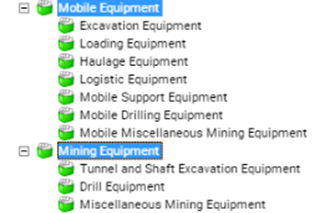Developing the CESK Data Mining Equipment Knowledgebase
Within the CESK Data (The Cleopatra Enterprise Standard Knowledgebase) product roadmap, developing cost data to cover the mining industry was a significant step. This article will shed light on the entire process that transpired within the data team to achieve this milestone.
During our research we came across a study on 65 gold mining projects that showed an average project cost overrun of 45 percent [1] (Wetterhahn, 2018). The combination of limited availability of skilled personnel, market fluctuations and limited accessibility to data contributed to cost overruns.
Factors such as the mining method (Open pit vs underground) and the type of mineral processed (Iron vs gold) are several project parameters that were published and used as a means to conduct the analysis. This emphasized the need to have parameterized cost models [2] for different mining equipment used in various parts of the value chain.

Scoping and Development of the Mining Database
As concluded from our research, having parameterized cost models was an important addition to our database. Because it would have provided our clients in the mining industry with much more accurate cost estimations depending on the types of mining equipment used in different parts of the value chain. Thus our team began to scope and develop the mining database.
The mining knowledgebase was divided logically based on a literature survey on the major equipment. This also split the models depending on which activities they were used for:
- Exploration: Drilling and Supporting equipment
- Logistics: Loading and unloading
- Processing: Concentrating, Refining, Grinding, Milling, Sizing, and Classification
- Surface mining: Drills, excavators, Haulage, Loaders, Scrapers, and supporting equipment
- Underground mining: Drills, excavators, Haulage, Loaders, Scrapers, and supporting equipment, Tunnelling
Cost data was collected from literary sources and vendor-published information, resulting in multi-variable regression models similar to the existing “Process Equipment Models” within the CESK Data. This xercise also enhanced several processing types of equipment already present within the CESK Data to be used with mining equipment standards.

Integration with CESK Data
Content structure
- To ensure a seamless user experience and promote uniformity within the knowledgebase, the mining content structure should align entirely with the existing CESK Data content structure.

Factor Methodology
- To support early-stage factored estimates, a factor methodology for the mining Industry was developed based on available CAPEX breakdowns.
Breakdown structures
To ensure that our existing CESK Data users can also make use of the additional data while reporting them in the same manner, we have to assign these models to the standard breakdown structures. To structure them correctly within our existing breakdown structures new keys have been created under both the “CBS” and “Equipment” breakdown structures, as shown below. By doing this, we ensure that existing estimate templates and reports can be used without modifications.


Indexation
The next step in the development cycle is to integrate these models within the CESK Data family of products. The mining knowledge base can be integrated with the CESK Data Objects/Equipment Datasets or be issued as a standalone dataset. The following aspects were considered during its integration.
To ensure that the calculated costs are up to date, the mining cost models were indexed to the latest price reference date. Since several vendor data were based on equipment manufacturers from North America, the “Producer Price Indices” from the Bureau of Labor Statistics (US) were used. The models were divided into the categories listed below :
- Mining Machinery and Equipment
- Underground mining machinery
- Mineral Processing and benefaction machinery
- Crushing, pulverizing, and screening machinery
- Drills and other machinery
- Parts and attachments for mining machinery
- Conveyors and Conveying equipment.
Release to Clients
In line with the existing CESK Data 2022 products, the mining knowledgebase is also released with additional deliverables:
- Templates: including labor rates, and breakdown structures.
- Factor tables
- Currency rate list
- Import scripts for equipment models (3 packages: Unit-Rates, Composites, and Objects)
- Excel Templates for equipment import scripts (3 templates: Uni-Rates, Composites, and Objects)
- A good CTA at the end
Do you want to know more about our CESK Mining database? Please feel free to contact us.
[1] Wetterhahn, J. P. (2018). A method to assess the likelihood and magnitude of initial capital expenditure overruns of future gold mining projects using retrospective data analysis
[2] A cost model is a calculation model within Cleopatra Enterprise that receives a user’s input and calculates costs and other elements using mathematical formula’s/relations